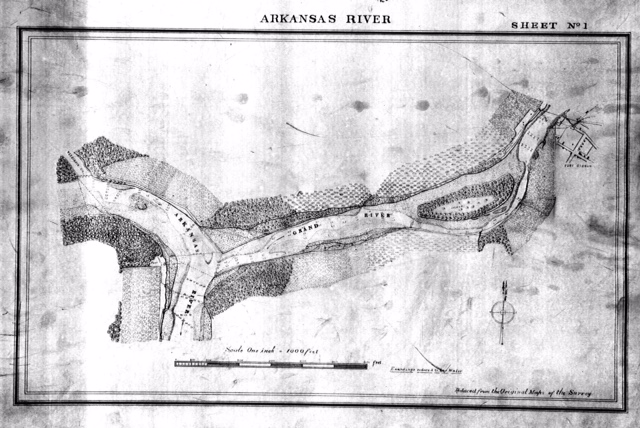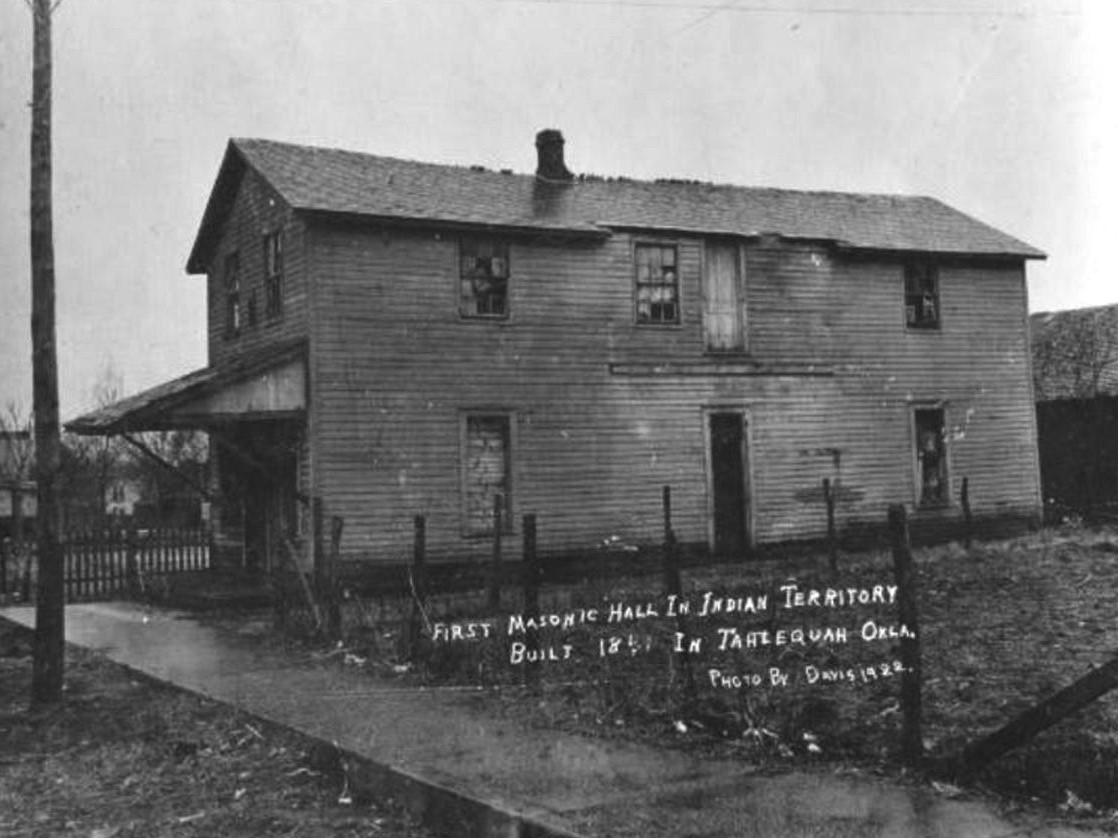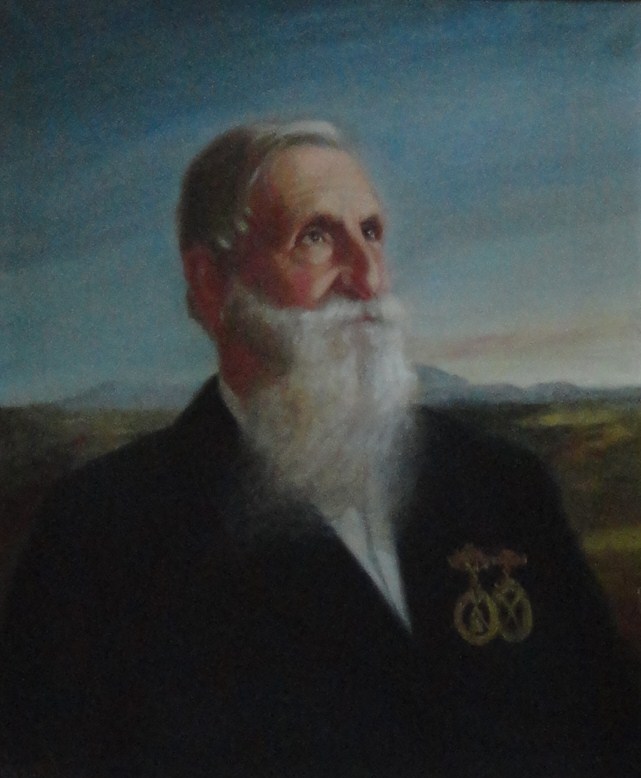
Freemasonry Among the Five Tribes
By T.S. Akers
Oklahoma is a Choctaw word meaning “red people.” The name
was first proposed by Choctaw Principal Chief Allen Wright during treaty
negotiations with the federal government in 1866.[i]
Wright’s suggestion was employed by the Brethren of Oklahoma Lodge No. 217
when that Lodge was chartered in 1868.[ii]
The region that became Oklahoma was originally home to
the Caddo, Osage, and Wichita Nations. Cherokees who had voluntarily
migrated to Arkansas in 1812, would periodically cross into Osage country,
leading to an ongoing feud between the two tribes. This caused Col.
Matthew Arbuckle to move elements of the 7th US Infantry
Regiment west from Fort Smith in 1824 to establish a post at the
confluence of the Grand and Arkansas Rivers, in order to maintain peace on
the frontier.[iii]
The establishment of Fort Gibson by Arbuckle, a Freemason, ushered in the
arrival of Freemasonry in the region.[iv]

Early map of the Arkansas River, illustrating the location of
Fort Gibson
(Courtesy of the Oklahoma Historical Society)
While some Choctaw and Chickasaw hunting parties regularly
came to what would become the Indian Territory in pursuit of buffalo, the
first full scale emigration of the Five Tribes occurred in 1827 when roughly
700 Creeks led by Chilly McIntosh made their way west in the wake of the
Treaty of Indian Springs. Known as the McIntosh Party for their support of
Chief William McIntosh in his ceding of Creek lands for land west of the
Mississippi, these Creeks settled in the Three Forks area near Fort Gibson.[v]
The Western or Old Settler Cherokees were removed from Arkansas the
following year.
[vi] It is estimated that the Indian Removal Act of 1830 would
see over 58,000 members of the Five Tribes either emigrate or be forcibly
removed to the Indian Territory.
The Five Tribes were, as they remain today, sovereign
nations. This required the United States to enter into treaties with the
Five Tribes, which often made travel to Washington, DC, necessary for tribal
headmen. For the mixed bloods that dominated tribal politics, this
interaction with white culture was not foreign. The Cherokee William P.
Ross, the Choctaw Peter Pitchlynn, and the Creek Chilly McIntosh were all of
Scottish descent. It was on a diplomatic visit to Washington, DC, that
William P. Ross was made a Freemason at Federal Lodge No. 1 in 1848.[vii]
Pitchlynn would also become a Freemason in Washington, DC, and both he and
Ross became Royal Arch Masons there.[viii]
The 1839 Act of Union brought together the Western Cherokees,
formerly of Arkansas, and the recently removed Cherokees as the Cherokee
Nation, establishing their capital at Tahlequah.[ix]
It was here on November 9, 1848, that Cherokee Lodge No. 21 was chartered by
the Grand Lodge of Arkansas. The first Lodge Secretary was William P. Ross.
Additional Lodges, with primarily indigenous membership, that were chartered
included Choctaw Lodge No. 52, Flint Lodge No. 74, and Muscogee Lodge No.
93.[x]
Also among the membership of these Lodges were other important Brethren,
Christian Missionaries. The Methodist Thomas Bertholf held membership at
Cherokee Lodge.[xi]
At Muscogee Lodge was the Baptist H.F. Buckner.[xii]
These men became acquainted with another Baptist missionary, and soon to be
Brother, named Joseph S. Murrow.

The first meeting hall of Cherokee Lodge No. 21
(Courtesy of the McAlester Scottish Rite)
Some have contended that the men of the Five Tribes found
something similar in Freemasonry that they had experienced elsewhere. There
is reference to a Choctaw “Horse Masonry” with signs and grips. Edmond H.
Doyle, an early Masonic luminary in the Indian Territory, often told a story
of meeting a non-English speaking Choctaw in 1876 in the dark of night.
Doyle, seeking shelter from a storm, gave a sign which the Choctaw
recognized and greeted Doyle with hospitality.
[xiii] Others have referenced a fraternity of “Indian Blood
Brothers” with a stone altar bearing the Square and Compasses as a familiar
sight to Native Americans, bringing them to Freemasonry.
[xiv] However, what many men of the Five Tribes saw in
Freemasonry was a connection that could help preserve their Tribal
existence. Conversions to Christianity were common among the Five Tribes in
the 19th century. Chilly McIntosh, of the Creek Nation, was
ordained as a Baptist minister by the Rev. H.F. Buckner, a Freemason, in
1848. [xv]
Chilly’s half-brother Daniel N. McIntosh, a member of Muscogee Lodge, also
became a Baptist minister.
[xvi] The men who were either responsible for providing for
the needs of the Five Tribes, or who could provide legislative influence,
were often Freemasons. For the Five Tribes, it was the Masonic Lodge that
could be turned to for schools, churches, relief agencies, and post offices.
[xvii]
The Civil War would interrupt Freemasonry in the Indian
Territory and it was particularly devastating to the region. The War did
bring two notable men to the Indian Territory. In March of 1861, Albert Pike
was appointed commissioner to the Indian Territory by the Confederacy for
the purpose of negotiating an alliance with the Five Tribes.
[xviii]
Pike had become a Freemason in Western Lodge No. 2 of
Little Rock, Arkansas, in 1850. He was elected Sovereign Grand Commander of
the Scottish Rite in 1859.
[xix] Pike, having represented
the Creek, Chickasaw, and Choctaw Nations in legal claims against the
federal government, would personally make the Choctaw Peter Pitchlynn a 33rd
Degree Mason in 1860.
[xx] By 1862, Pike had been
commissioned a Brigadier General, making him the ranking Confederate officer
in the Indian Territory.
[xxi] His tenure as a combat
general would be brief, resigning later in the year. Pike’s resignation was
prompted by orders to move his Indian Brigade outside of the Indian
Territory, which violated treaty stipulations, and due to the lack of
material being provided his command.
[xxii] Again, the men of the Five Tribes saw a Freemason who
placed their well-being first and several of the signatories of the
Confederate treaties that Pike negotiated held Masonic membership.
Also working to see to the needs of the Five Tribes at this
time was Joseph S. Murrow. Murrow arrived in the Creek Nation in 1857
to assist the Rev. H.F. Buckner, a member of Muscogee Lodge. As the federal
government withdrew from the Indian Territory in 1861, Murrow was appointed
as Confederate agent to the Seminoles; he had organized a church in the
Seminole Nation in 1859. As the situation grew worse in the Indian Territory
during the Civil War, Murrow and his family took refuge in Texas.
[xxiii]
It was in Texas that he became a Freemason in Andrew
Jackson Lodge No. 88 in 1866.
[xxiv] Murrow returned
to the Indian Territory in 1868, establishing another church at Boggy Depot.
[xxv]
It was at Boggy Depot that Freemasonry sprang to life again in the Indian
Territory with the establishment of Oklahoma Lodge No. 217 that same year.
Murrow would go on to be a charter member of the first of numerous Masonic
orders in the Indian Territory, including Indian Chapter No. 1 of Royal Arch
Masons at McAlester, Oklahoma Council No. 1 of Royal and Select Masters at
Atoka, and Muskogee Commandery No. 1 of Knights Templar. Murrow’s continued
dedication to the welfare of the Five Tribes culminated in his co-founding
of Indian University, now Bacone College, in 1880 and his establishment of
the Murrow Indian Orphans Home.
[xxvi] The men of the
Five Tribes could find no better example to emulate than that of Freemason
Joseph S. Murrow.

Joseph S.
Murrow
(An oil portrait from
the collections of the McAlester Scottish Rite)
________________________
[i]
John D. May, "Wright, Allen (1826–1885),"
The Encyclopedia of Oklahoma History and
Culture,
accessed August 8, 2018, http://www.okhistory.org/publications/enc/entry.php?entry=WR004.
[ii]
J. Fred Latham, The Story of Oklahoma Masonry (Guthrie, OK: Grand
Lodge of Oklahoma, 1978), 14.
[iii]
Brad Agnew, “Fort Gibson,” The Encyclopedia of Oklahoma History and
Culture, accessed August 8, 2018, http://www.okhistory.org/publications/enc/entry.php?entry=FO033.
[iv]
William R. Denslow, 10,000 Famous Freemasons (Trenton, MO:
Missouri Lodge of Research, 1957).
[v]
Christopher D. Haveman, “With Great Difficulty and Labour: The
Emigration of the McIntosh Party of Creek Indians, 1827-1828,” The
Chronicles of Oklahoma 85, no. 4 (2007-2008): 474-479.
[vi]
“Removal of Tribes to Oklahoma,” The Oklahoma Historical Society,
accessed August 8, 2018, http://www.okhistory.org/research/airemoval.
[vii]
“History of Federal,” Federal Lodge No. 1: Free and Accepted Masons
of Washington, D.C., accessed August 8, 2018, http://www.federallodge.org/about-us/lodge-history/.
[viii]
Charles E. Creager, History of Freemasonry in Oklahoma (Muskogee:
Muskogee Print Shop, 1935), 61.
[ix]
Rennard Strickland, “Cherokee,” The Encyclopedia of Oklahoma History
and Culture, accessed August 8, 2018, http://www.okhistory.org/publications/enc/entry.php?entry=CH014.
[x]
Creager, History of Freemasonry in Oklahoma, 20-28.
[xiii]
Charles E. Creager, A History of the Cryptic Rite of Freemasonry in
Oklahoma (Muskogee: Hoffman-Speed Printing Co., 1925), 18-19.
[xiv]
Bliss Kelly, “Are Indian ‘Blood Brothers’ Masonic?,” in Oklahoma
Lodge of Research Volume 1 (Guthrie: Oklahoma Lodge of Research,
2017), 63.
[xv]
J.M. Gaskin, Trail Blazers of Sooner Baptists (Shawnee: Oklahoma
Baptist University Press, 1953), 117-169.
[xvi]
Proceedings of the Most Worshipful Grand Lodge AF&AM of the Indian
Territory (Caddo: Oklahoma Star, 1875), 24.
[xvii]
Joy Porter, Native American Freemasonry: Associationalism and
Performance in America (Lincoln: University of Nebraska Press,
2011), 212.
[xviii]
LeRoy H. Fischer and Jerry Gill, Confederate Indian Forces Outside of
Indian Territory (Oklahoma City: Oklahoma Historical Society, 1969),
1.
[xix]
James T. Tresner II, Albert Pike: The Man Beyond the Monument
(New York: M. Evans and Company, 1995), 236-237.
[xxi]
Roy A. Clifford, “The Indian Regiments in the Battle of Pea Ridge,”
The Chronicles of Oklahoma 25, no. 4 (1947): 315.
[xxii]
Ingrid P. Westmoreland, “Pike, Albert (1809-1891),” The Encyclopedia
of Oklahoma History and Culture, accessed August 8, 2018, http://www.okhistory.org/publications/enc/entry.php?entry=PI006.
[xxiii]
Andrea M. Martin, “Murrow, Joseph Samuel (1835–1929),” The
Encyclopedia of Oklahoma History and Culture, accessed August 8,
2018, http://www.okhistory.org/publications/enc/entry.php?entry=MU016.
[xxiv]
“Joseph Samuel Murrow,” in Grand Masters of Oklahoma (Guthrie:
Oklahoma Lodge of Research, 1975), 9.
[xxvi]
“Joseph Samuel Murrow,” 9.

|
